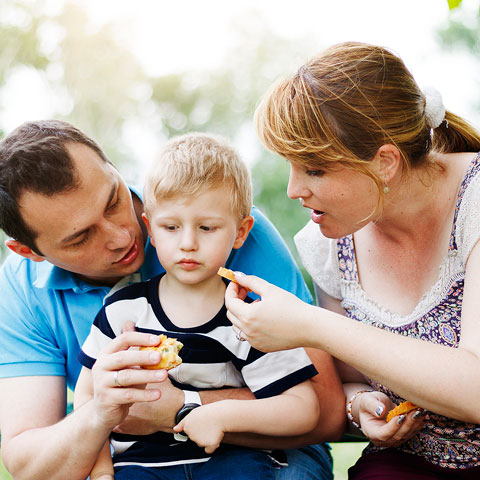Picky Eating and Healthy Nutrition for Young Children
This topical guide will introduce you to important books, videos, and information resources available from the EI Clearinghouse and other sources. Contact us via online form or by phone (1-877-275-3227) to request a resource listed below (or ask your local public librarian). Note that some videos may be viewed online, and journal titles will take you to the publisher’s homepage.
Table of Contents

EIC Resources
Books
Picky eating is a huge stress to parents. What if you could help negate overly choosey eaters from the day you introduce food? Baby self-feeding puts your child in the driver’s seat from the moment food is introduced, helping to establish a positive relationship from day one and creating a willingness to try new things!
This book gives an easy-to-follow introduction to baby-led feeding or weaning, including chapters on the benefits of this approach, when and how to get started, essential safety and nutrition guidelines, frequently asked questions, basic fruit and vegetable prep, more complex finger foods, and family meals.
Baby-led weaning is the healthy, natural way to start your baby on solid foods–no stress, no fuss, no mush! This tenth anniversary edition of the definitive guide explains all its benefits.
This practical handbook contains vital information and advice for all nutritionists and dietitians working with young children and families. It will also be a valuable text for health visitors, pediatricians and general practitioners, and students of nutrition and dietetics specializing in pediatric nutrition.
This book reveals secrets for better breast and bottle feeding and feeding development for babies from birth to the toddler years.
Food Chaining helps you identify the reasons behind your child’s picky eating habits — be it medical, sensory, or because of allergies. Then, with a simple, 6-step method centered around taste, temperature, and texture, target foods are selected that are similar to the ones your child likes, gradually expanding to all food groups.
With practical advice, feeding tips, and resources for low-pressure mealtimes, this parenting book will ensure that your child is getting good nutrition while also promoting a healthy relationship with food and expanding their repertoire for even the pickiest of eaters!
This book presents 5 steps (built around the clinically proven STEPS+ approach―Supportive Treatment of Eating in PartnershipS) that transform feeding and meals so your child can learn to enjoy a variety of foods in the right amounts for healthy growth.
This book describes the three habits – proportion, variety, and moderation – all kids need to learn, and gives you clever, practical ways to teach these food skills.
This book explains how to expand your family’s food horizons, avoid the picky eater trap, identify special feeding needs, and put joy back into mealtimes.
Potock guides parents along every step of the way, from “to bib or not to bib?” and how to wrangle a “food thrower” to the merits of a “nibble tray” for hangry toddlers and considerations for special needs. Raising a mindful, healthy eater s just a bite away!
Parents can learn how and when to begin baby-led weaning and find out what you can expect along the way. Pick up practical advice for creating balanced meals and eating them together. A handy to-scale diagram takes the guesswork out of safe serving sizes–so baby can join the dinner table and eat with the family.
This book provides practical, easy-to-follow advice to help you navigate the nutrition issues, medical conditions, and parenting concerns that accompany feeding.
Providing recipes for many simple, healthy meals given the Asperger seal of approval, as well as advice for making mealtime routines, eating together as a family and eating out as stress-free as possible, the book provides a wealth of ideas and strategies for moving towards a more varied and nutritious diet.
Videos and Media
Mealtimes offer opportunities for parents and children to build healthy relationships. When a child struggles to eat, it can significantly change the way he or she participates in mealtime routines. This recorded webinar, presented by Stephanie Cohen & Karen Dilfer, highlights the need to build trust between providers, families, and children in order to support family-focused mealtime routines.
Organizations
No resources have been added to this section yet. However, new resources are added frequently!Articles
Food chaining has been developed as a systematic method for the treatment of children with extreme food selectivity. Food chaining is an individualized, nonthreatening, home-based feeding program designed to expand food repertoire by emphasizing similar features between accepted and targeted food items.
Web Resources
This article provides tips that can help you get through the picky eater stage.
Children’s nutrition doesn’t have to be frustrating. Consider these strategies to avoid power struggles and help the picky eater in your family eat a balanced diet.
Good nutrition is basic for supporting preschoolers’ healthy growth while avoiding obesity. Parents can offer the foods that children need and help them develop good eating habits. Also in Polish and Arabic.
These tips from the Children’s Hospital of Philadelphia will help parents broaden their child’s range of foods they eat.
Children can easily drink a lot of juice because juice tastes good. However, too much juice in your child’s diet can contribute to other problems, like poor nutrition, obesity, and tooth decay.
Good nutrition is basic for supporting preschoolers’ healthy growth while avoiding obesity. Also available in Polish, Korean, Chinese, Arabic, and French.
“Picky” eating is when a child (or adult) refuses foods often or eats the same foods over and over. Here’s what to do and what not to do with your picky eater.
Picky eating is typical for many preschoolers. It’s simply another step in the process of growing up and becoming independent. As long as your preschooler is healthy, growing normally, and has plenty of energy, he or she is most likely getting the nutrients he or she needs.

